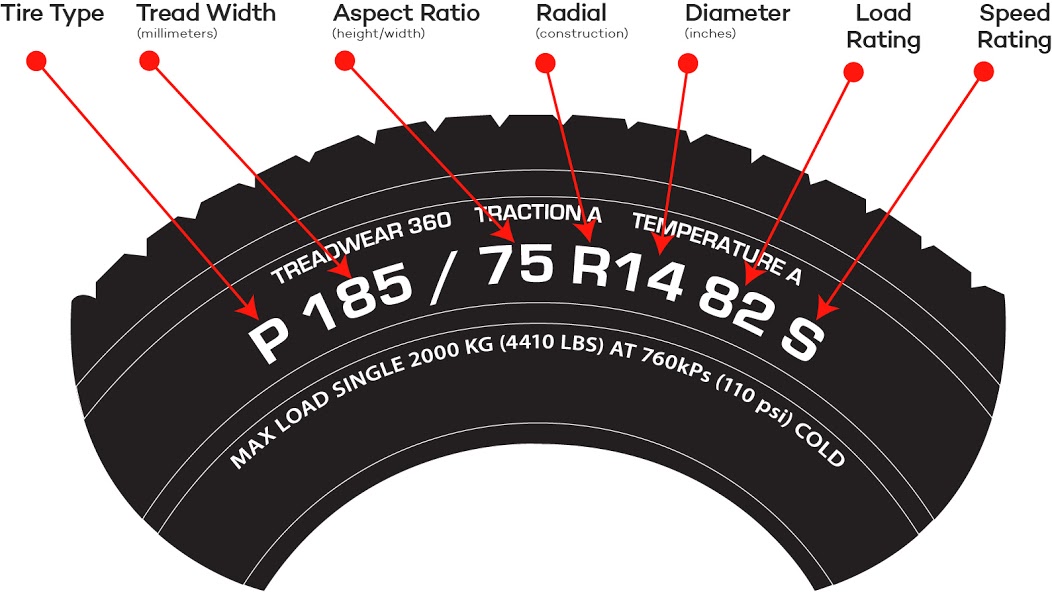Home > Company > Tire Safety > Choosing Tires > Determining Tire Size
Once you have determined it’s time to buy tires, you’ll need to know what size tires are correct for your vehicle. Depending on what you drive, you may be interested in how to find the right tire for your…
This information is usually inside your car’s doorjamb, in your owner’s manual. To ensure your current tire or a replacement tire you may be looking at matches your vehicle’s requirements, it will be good for you to understand how tire sizing works. You may have never paid attention to the string of numbers and letters on every tire, but it’s a gold mine of information.
If you’re unsure of how to read tire measurements from your tire walls, the information and graphics below will tell you how to read tire size, understand and interpret it. If you decide you want to substitute a new size or tire type, consult an authorized tire retailer who can expertly advise you, because many optional tire sizes may have different load capacities and could require wheels of a different rim width or diameter and different inflation pressure.
Not sure you need new tires? Our Tire Replacement Guidance article will help you determine whether it’s time to retire your tires.
Most passenger cars, SUVs and light pickups (1/2 ton and smaller) will come with tires that are either P-Metric or Euro-Metric. For P-Metric tires, you’ll see the letter “P” before the number sequence begins: P225/70R16 97H. P-metric is a designation standardized by the Tire and Rim Association for a “passenger car” tire type. For Euro-Metric there will be no preceding letter before the number sequence begins: 225/70R16 98H. Euro-Metric is a designation standardized by the European Tyre and Rim Technical Organization for a “passenger car” tire type. Both P-Metric and Euro-Metric size tires are designed to primarily be used on passenger vehicles, which can include cars, minivans, SUVs, and other light duty pickup trucks.
Both P-Metric and Euro-Metric size tires are designed to primarily be used on passenger vehicles, which can include cars, minivans, SUVs, and other light duty pickup trucks.
If your vehicle is an SUV, Pickup truck or van, you might see a different type of size designation on your placard that is specific for heavy duty light trucks and vans, especially common on ¾ ton and larger pickup trucks and vans. There are two common size types in this category, LT-Metric and Euro-Metric Commercial (aka C-type). Both size types are metric and so use the same structure as P-Metric and Euro-Metric but have some different characters in the size that differentiate them from their passenger car cousins. LT-Metric tires will have the letters “LT” before the size number sequence: LT245/75R17 119/116R Load Range E. Notice that there are two load index numbers and a Load Range, see the section on Load Index for more info. LT-Metric is a designation standardized by the Tire and Rim Association for a “light truck” type tire. Euro-Metric Commercial or C-Type tires will look very similar to a passenger Euro-Metric size except that there will be a “C” right after the rim size: 23/65R16C 121/119R. Notice that the C-type tires also have two load index numbers. Euro-Metric Commercial, or C-Type is a designation standardized by the European Tyre and Rim Technical Organization for a light truck type tire. Light truck tires are designed to be used on vehicles capable of carrying heavy cargo and are usually only specified by a vehicle manufacturer on vehicles exceeding a certain load capacity.
Euro-Metric Commercial or C-Type tires will look very similar to a passenger Euro-Metric size except that there will be a “C” right after the rim size: 23/65R16C 121/119R. Notice that the C-type tires also have two load index numbers. Euro-Metric Commercial, or C-Type is a designation standardized by the European Tyre and Rim Technical Organization for a light truck type tire. Light truck tires are designed to be used on vehicles capable of carrying heavy cargo and are usually only specified by a vehicle manufacturer on vehicles exceeding a certain load capacity.
Other types of tires that fall into the Metric sizing type are Temporary Spares, they start with “T”. If you see a size that starts with “ST,” that means “special trailer” and is only for use on a trailer.
Regardless of whether you are looking at a P-Metric, Euro-Metric, LT-Metric, Euro-Metric Commercial, T or ST tire the numbers in the size mean the same thing.
The first number to appear in your tire size information is the width, in millimeters, of the correct tires for your vehicle: P225/70R16 91S.
Tire width always refers to the measurement from one sidewall to another. Thus, a tire with the measurement “P225” is for a passenger vehicle and has a nominal width of 225 millimeters.
After the slash mark, the next number you see is for the tire’s aspect ratio, which essentially tells you how tall your tire’s profile is: P225/70R16 91S. Aspect ratios are delivered in percentages. Tire makers calculate the aspect ratio by dividing a tire’s height off the rim by its width. If a tire has an aspect ratio of 70, it means the tire’s height is 70% of its width.
Lower aspect ratio tires, such as a 60 series, generally offer vehicle handling performance advantages over higher aspect ratio tires, such as a 75 series, but a typical trade off can be ride harshness.
After the aspect ratio comes a letter that indicates the type of internal construction maintaining your tire’s stability: P225/70R16 91S.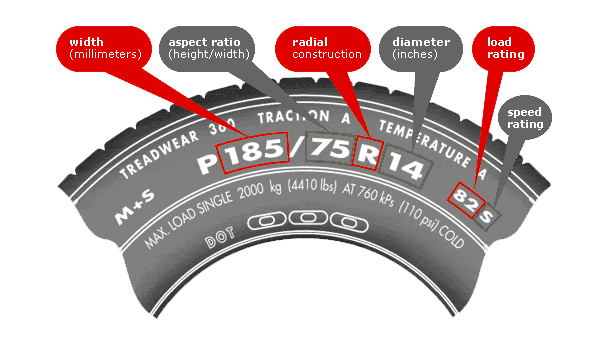
There are two types of construction that you may see on the sidewall of a tire:
Radial tires are the most common tires on the road in the United States today; thus “R” will usually be shown in the tire size designation. Radial construction means the tire’s internal ply cords are oriented in a radial direction, from one bead over to the other, essentially perpendicular to the direction of rotation. You may also occasionally see RF indicating a run flat tire or ZR indicating a tire that is a speed rating higher than V.
The next number is the diameter code, in inches, of the rim onto which the tire can be mounted. For example, a tire with the P225/70R16 91S would fit a rim with a 16-inch diameter.
Load index can be a confusing subject because there are so many different caveats, but we will try to explain everything here.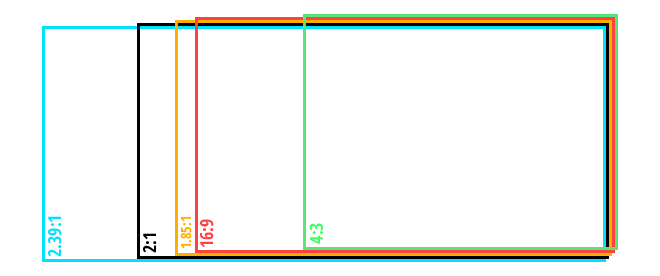
The next figure after the rim size in the sequence is your tire’s load index, which tells us how much weight, in pounds, the tire can support when fully inflated: P225/70R16 91S
We call it the load “index” because the number doesn’t tell us the precise number of pounds the tire can carry, at least not by itself. However, the number does correspond to a specific load capacity listed in an index. Beginning with 1 and ending with 150, numbers in the load index represent carrying capacities of 99 to 7385 lbs.
There are two types of load types for passenger tires though, Standard Load and Extra Load. If a tire is Standard Load there will be no markings indicating it but if it is Extra Load the letters XL will appear after the size and load index.
Standard Load Euro-Metric: 215/55R17 94V
Extra Load Euro-Metric: 215/55R17 98V XL
Passenger car tires like P-Metric and Euro-Metric will only have one load index number where LT-Metric and Euro-Metric Commercial (C-Type) will have two numbers separated by a slash.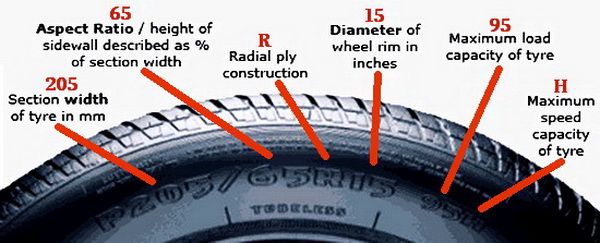 The first number is the load index if the tire is used in a single application, the second number is the load index if the tire is used in a dual application. Passenger type tires cannot be used in a dual application. Light truck tires will also have a Load Range that is indicated by a letter, such as Load Range E. Load Range is an older term that is still commonly used in the industry so you may hear your tire dealer reference it but the load index numbers are the best way to ensure you have the proper tire.
The first number is the load index if the tire is used in a single application, the second number is the load index if the tire is used in a dual application. Passenger type tires cannot be used in a dual application. Light truck tires will also have a Load Range that is indicated by a letter, such as Load Range E. Load Range is an older term that is still commonly used in the industry so you may hear your tire dealer reference it but the load index numbers are the best way to ensure you have the proper tire.
One important but often misunderstood facet about load index is that the load index numbers between standards organizations (P-Metric vs Euro-Metric) are not necessarily on the same scale. Meaning that two tires in the two different systems that have the same load index number could have different maximum load capacities. This is why it’s important to not only look at the load index number but also verify the actual load capacity.
The final figure in a tire size sequence is the speed rating, which is indicated by a letter: P225/70R16 91S.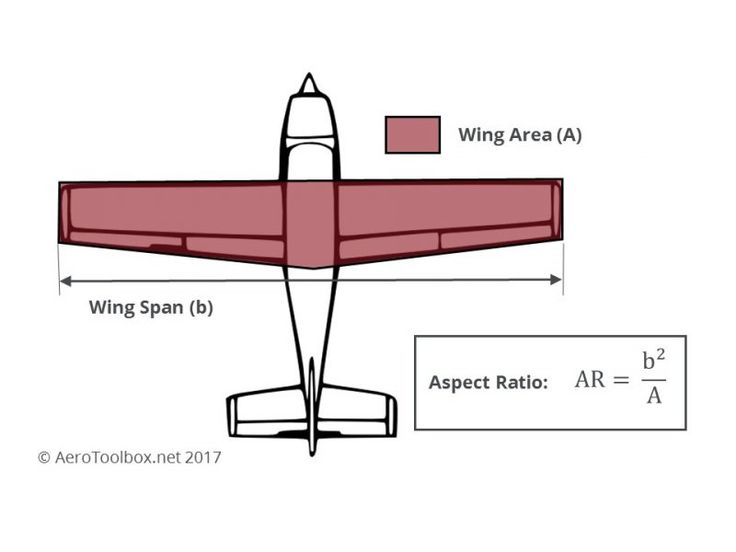 Just as your load index number corresponds to a specific load, your speed rating letter corresponds to a particular speed capability based on a standardized laboratory test.
Just as your load index number corresponds to a specific load, your speed rating letter corresponds to a particular speed capability based on a standardized laboratory test.
For example, a tire with speed rating “S” is rated for up to 112 mph, while a tire rated “R” is up to 106 mph. Remember that this isn’t a recommended cruising speed. Of course, you should always follow legal speed limits on roadways.
Replacement tires must have the same or higher speed rating as the vehicle’s Original Equipment to maintain vehicle speed capability. If a vehicle has tires with different speed ratings, it is the speed rating of the “slowest” tire that dictates the vehicle top speed.
There is one last sizing type that you should know about, especially if you are in the market for off road tires for a light truck or SUV. It’s called a Flotation size and the numbers in this sizing format are very different from the Metric formats.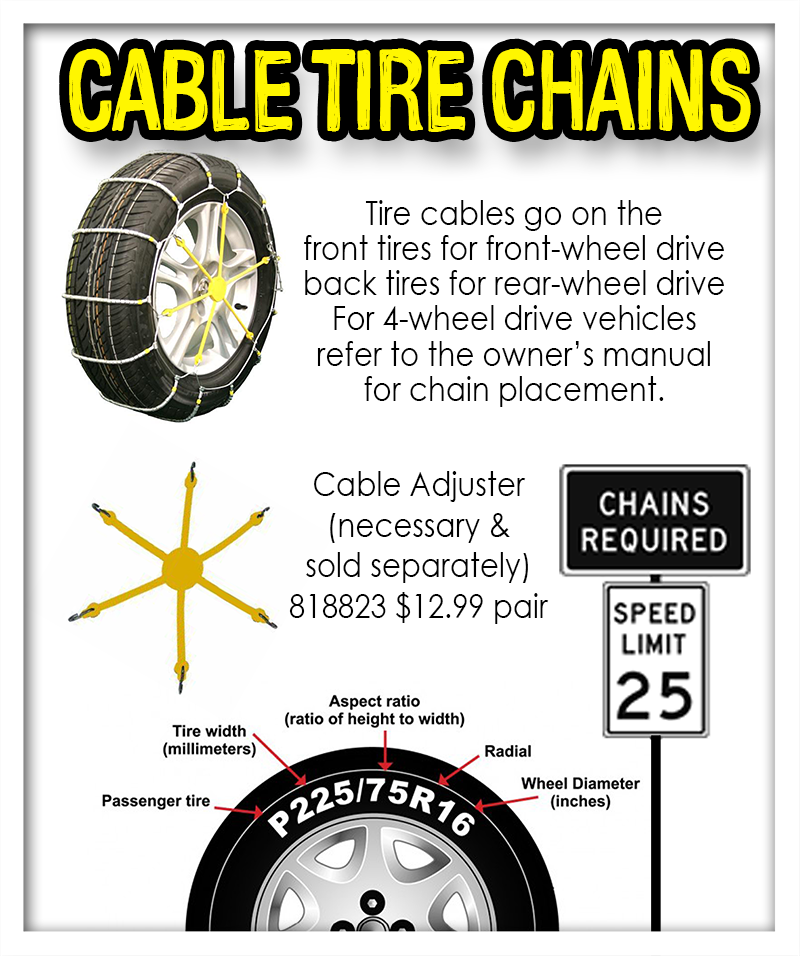 Flotation sized tires are similar to LT-Metric tires in application except for a few important points. Number one, they cannot be used in dual applications and number two, an equivalent size tire may have different load capacity than its LT-Metric counterpart.
Flotation sized tires are similar to LT-Metric tires in application except for a few important points. Number one, they cannot be used in dual applications and number two, an equivalent size tire may have different load capacity than its LT-Metric counterpart.
The first number in the Flotation tire size is the overall diameter in inches. Pretty straight forward.
The second number is the section width (sidewall to sidewall) measurement in inches. Again, fairly simple.
After the section width comes a letter that indicates the type of internal construction: 33X12.50R17LT 120Q.
This is the same as is found in the metric sizing systems.
There are two types of construction that you may see on the sidewall of a tire:
Radial tires are the most common tires on the road in the United States today; thus “R” will usually be shown in the tire size designation. Radial construction means the tire’s internal ply cords are oriented in a radial direction, from one bead over to the other, essentially perpendicular to the direction of rotation.
Radial construction means the tire’s internal ply cords are oriented in a radial direction, from one bead over to the other, essentially perpendicular to the direction of rotation.
The next number is the diameter code, in inches, of the rim onto which the tire can be mounted. For example, a tire with the 33X12.50R17LT 120Q would fit a rim with a 17-inch diameter.
The letters LT will be after the Rim Diameter indicating that this tire type is intended for Light Truck vehicles similar to the LT-Metric and Euro-Metric Commercial (C-Type) tires.
Load Index and Speed Rating have the same meaning and format as the tires using the metric sizing system. Note that since flotation tires cannot be used in a dual application there will be only one load index number instead of two.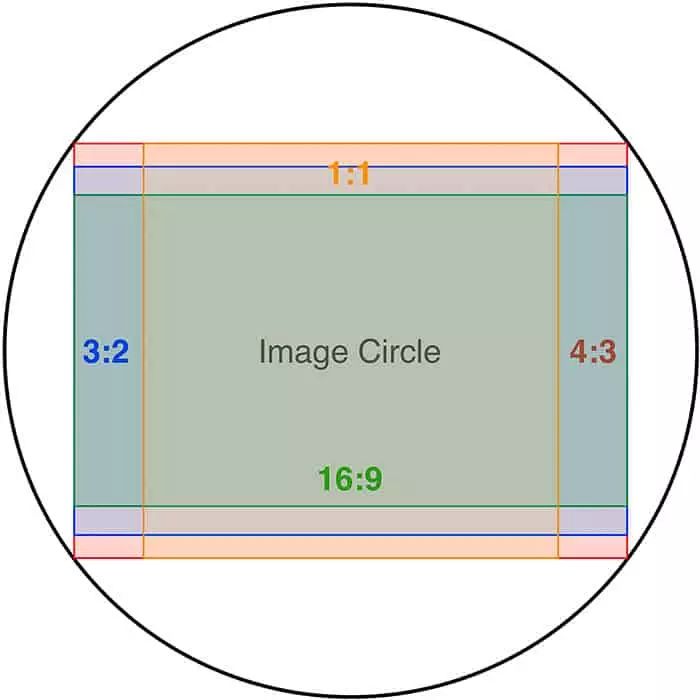
Another group of stamping on certain types of tires is the Uniform Tire Quality Grading or UTQG. This grading and stamping is required for passenger car tires (i.e. P-metric and Euro-metric) in the all season and summer categories. Dedicated winter tires, Light Truck (LT-Metric, Euro-Metric Commercial, Flotation) and Motorcycle tires are excluded from this requirement.
Quality grading is designed to make the tire purchase decision easier for you. Ideally, the system is intended to provide simple, comparative data so you can make an intelligent buying decision. However, the ratings are based upon test results achieved under special conditions. This means it’s possible to misinterpret the comparative data as it relates to your individual driving habits, conditions, etc. You should still rely on your service or tire professional for assistance.
Quality grading designates the comparative performance levels of a tire based on government-specified tests but commissioned by the individual tire manufacturers.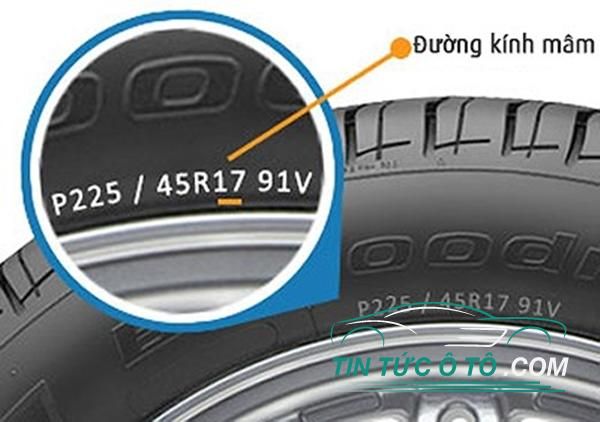 All tire manufacturers are required to grade regular and all-season passenger tires in three categories:
All tire manufacturers are required to grade regular and all-season passenger tires in three categories:
UTQG
Treadwear
The treadwear grade is a comparative rating based on the wear rate of the tire when tested under controlled conditions on a specified government test course for 6,000 miles (9,600 km). For example, a tire graded 150 would wear one and a half times as well on the government course as a tire graded 100. However actual tire performance depends on driving habits, road characteristics, service practices, and other factors that can influence the outcome.
Traction Grades AA, A, B and C
The traction grades from highest to lowest are AA (the highest), A, B and C. They represent how well tires stop on wet pavement as measured under controlled conditions on specified government test surfaces of asphalt and concrete. C-rated tires will have the lowest traction performance.
WARNING: THE TRACTION GRADE ASSIGNED IS BASED ON A WET BRAKING (STRAIGHT AHEAD) TRACTION TEST AND DOES NOT INCLUDE CORNERING (TURNING) TRACTION.
Temperature Grades A, B and C
The temperature grades A, B, and C represent the tire's resistance to the generation of heat and its ability to dissipate heat when tested under controlled conditions on a specified indoor laboratory test wheel. Sustained high temperature can cause the tire’s material to degenerate and reduce tire life, and excessive temperature can lead to sudden tire failure. The grade C corresponds to a performance level all passenger car tires must meet under the Federal Motor Vehicle Safety Standard No. 109. Grades A and B represent higher levels of performance on the laboratory test wheel than the minimum required by law.
WARNING: THE TEMPERATURE GRADE IS ESTABLISHED FOR A TIRE THAT IS PROPERLY INFLATED AND NOT OVERLOADED. EXCESSIVE SPEED, UNDER INFLATION, OR EXCESSIVE LOADING, EITHER SEPARATELY OR IN COMBINATION, CAN CAUSE HEAT BUILDUP AND POSSIBLE TIRE FAILURE.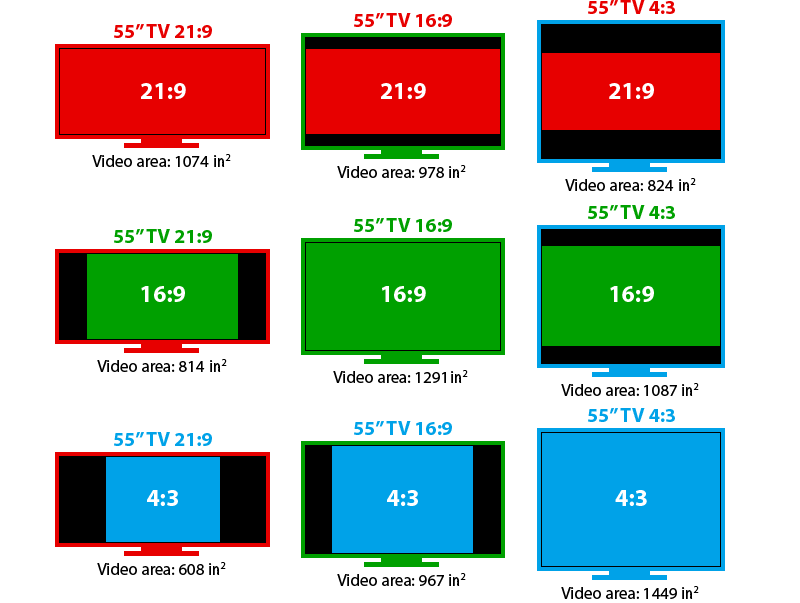
DOT Quality Grades
All passenger car tires must conform to other federal requirements in addition to these grades.
Learn about our mission, our achievements, and our ongoing commitments
Read Our Origin Story
8/5/2021
When you start looking at new tires, you realize that there are many different factors and sizes to keep in mind. And we mean a lot:
How wide is the tire?
How tall is the tire?
How fast can the tire go?
How much weight can the tire hold?
How much wood could a wood-tire chuck…
Wait, that last one is for something else. But you get our point. Many variables differ from tire to tire, and it’s important to know what they are and how they affect your ride.
Luckily, every tire on the market has this information stamped on its rubber sidewall. It’s pretty easy to spot and read—if you know what you’re looking for.
Today, we will talk about tire aspect ratio, where to find it on your tire, and what it means.
What Is a Tire Aspect Ratio?Tire aspect Ratio is the percentage ratio of the tire’s sidewall height compared to its rubber width.
Don’t worry; we’ll break it down for you. Tire Aspect Ratio is a percentage that reflects how much of a tire you see outside of the rim flange compared to its actual width.
The Aspect Ratio is pretty important and can determine how a tire looks and performs. As we mentioned, it’s conveniently available on the side of any tire.
Where Do You Find the Tire Aspect Ratio?The Aspect Ratio is stamped onto the exposed sidewall of any tire alongside a bunch of numbers and letters that tell you everything you need to know about your tire. It looks like this:
It looks like this:
265/60R18 110H
This example is the numbers you would find if you just bought a set of reliable Nexen Roadian HP tires online at RentAWheel.com for only $62 a month.
Granted, if you bought them through Rent A Wheel, you could have our professional tire technicians install them on your vehicle for free. Not to mention, with our state-of-the-art visualizer and our happy-to-help service, you always know your new tires will fit.
Still, you’re reading this because you want to know everything about your tires, which is fantastic. So, let’s carry on.
This string of numbers and letters might look confusing, but we’ll explain each piece step-by-step. From right to left, here’s how to read this handy little number.
WidthThe first number we see is “265.” This is the width of the tire from sidewall to sidewall in millimeters. It’s important to note that some of these numbers are in inches and some in millimeters, so keep an eye out! This is the first important number we’re looking for when shopping for rims. It’s also one of the important elements of finding the aspect ratio.
It’s also one of the important elements of finding the aspect ratio.
As we’ve mentioned, the aspect ratio is the sidewall height compared to its width. In this case, the tire height is 60% of its width.
Some quick math tells us that 60% of 265 millimeters is 159 millimeters. That’s the height of this tire’s sidewall.
So, that’s the aspect ratio. Because we know our readers are eager to learn everything they can, we’ll explain the rest of these numbers and letters for you, too.
ConstructionThis is the same on most tires you’ll encounter. The “R” means that the interior construction of the tire is radial.
DiameterThis might sound familiar from geometry class. Diameter is the measurement of the hole in the tire from one inner sidewall to the other.
Don’t get this confused with the height of the tire, which would be the diameter from where it touches the ground to its tallest point.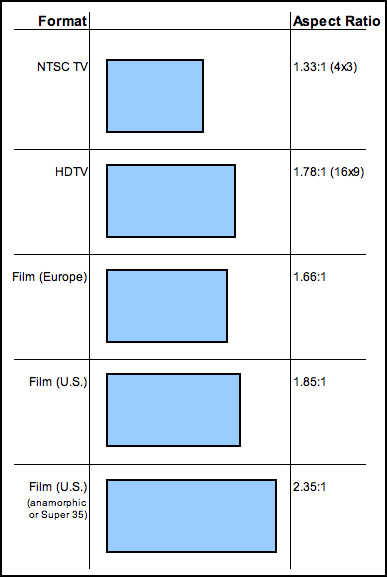 This is the size we look for when fitting rims.
This is the size we look for when fitting rims.
The diameter of our Nexens is 18 inches. Yes, we switched back to American measurements for this one.
Load IndexThe load index is at the end of this sequence. Well, almost the end. The load index number dictates the amount of weight this tire is rated to carry. In this case, the Nexen tires have a Load Index Number of 110, meaning they can support 2,337 pounds per tire. Multiply that by four, and you’ve got a set of wheels that can hold 9,348 pounds in total. Not too bad!
Speed IndexFinally, we get to the last letter! This is the speed rating identifier. This letter relates to the Tire Speed Rating Chart. Each letter on the chart tells you the tire’s maximum speed. So, our shiny new Nexen Roadian HP tires have a Speed Rating number of H. This chart tells us we can safely go 130 miles per hour. According to the tires, not speed laws, which Rent A Wheel always obeys and expects smart drivers to do the same!
What Does It Mean?So, what does your tire's aspect ratio mean for you? And why is it important when shopping for a new set?
Well, the higher the aspect ratio, the more sidewall you will see from your tire’s side profile.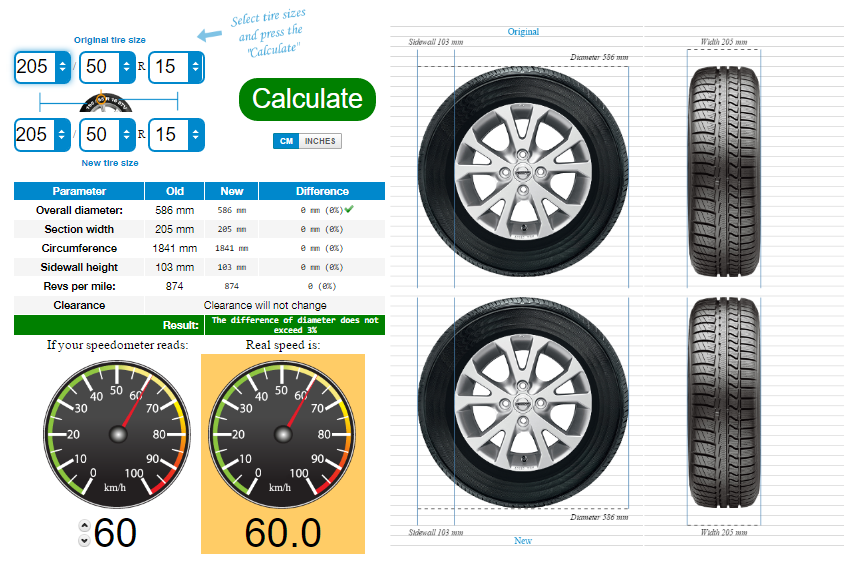 This has aesthetic implications, and some people have a particular vision for their vehicle’s look.
This has aesthetic implications, and some people have a particular vision for their vehicle’s look.
If you want a low-profile performance tire that almost blends with your sweet rims, keep an eye out for a lower aspect ratio.
If you’re looking to set up your Jeep or truck with a set of tires that you can take off-roading, a higher aspect ratio will help out because of its sidewall height. That extra rubber on the tire sides is going to add traction when you’re in the mud.
ConclusionAll in all, the tire aspect ratio is just one piece of information to keep in mind when shopping for new tires. What you’re planning on doing with your vehicle, where you drive, and what you want everything to look like is all affected by one number.
It’s also important to remember all the other bits of information we’ve covered. You can’t look at just one component when shopping for new tires. You have to pay attention to make sure you’re getting exactly what you need and want.
At Rent A Wheel, we have a team of professional tire experts ready to chat with you online about what tires will suit your needs best. We’ll get you fitted with the perfect tires and wheels for your vehicle.
Still a little confused on how the tires are going to look on your sick ride? Don’t worry; our state-of-the-art visualizer is here to help. Just input your car’s make, model, and color, and we’ll show you exactly how those brand-new tires and rims are going to look on the road.
If you’re thinking, “Gee-whiz, I wish I could buy new tires today, but the ones I want are just too expensive,” have no fear—Rent A Wheel is here.
Our flexible payment plan options mean that you can make low monthly payments on your tires over time instead of dropping a big wad of cash all at once.
We want to make sure every driver who chooses Rent A Wheel drives away with exactly what they want and need at a reasonable price.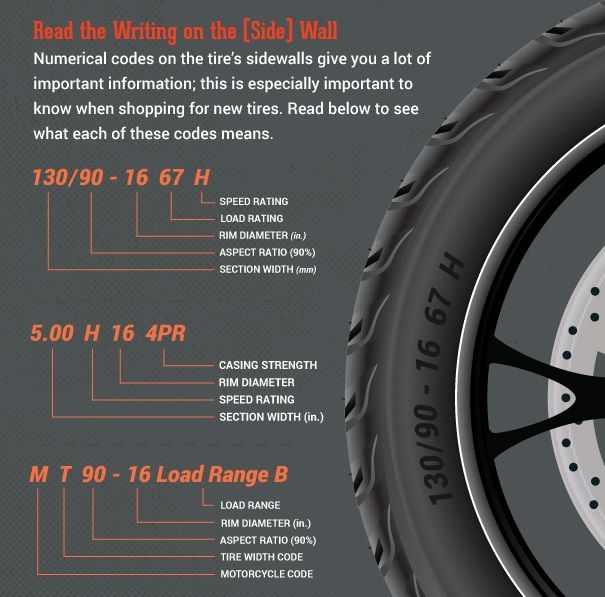 Did we mention that we’ll even install your newly purchased tires for free? That’s a pretty solid deal.
Did we mention that we’ll even install your newly purchased tires for free? That’s a pretty solid deal.
Sources:
How to Read Tire Size and Sidewall Markings | Live About
Tire Load Index Chart | Tyre Size Calculator
Tire Speed Rating Chart | Tyre Size Calculator
Home » Miscellaneous » How to determine the size of a car tire
Do you want to choose a tire for your car, but do not understand tire markings well? It's not a problem! In this section, we will help you figure out what tire parameters are, what they mean, and which tire is right for your car.
Select tires / tire catalog
195/65 R15 91 T XL
195 is the tire width in mm.
65 - Proportionality, i. e. profile height to width ratio. In our case, it is equal to 65%. Simply put, with the same width, the larger this indicator, the higher the tire will be and vice versa. Usually this value is simply called “profile”.
e. profile height to width ratio. In our case, it is equal to 65%. Simply put, with the same width, the larger this indicator, the higher the tire will be and vice versa. Usually this value is simply called “profile”.
Since the tire profile is a relative value, it is important to consider when choosing rubber that if you instead of size 195/65 R15, if you want to put tires with a size of 205/65 R15, then not only the width of the tire will increase, but also the height! Which in most cases is unacceptable! (except when both of these sizes are indicated in the car's operating book). You can calculate the exact data on changing the outer dimensions of the wheel in a special tire calculator.
If this ratio is not specified (for example, 185/R14C), then it is equal to 80-82% and the tire is called full profile. Reinforced tires with this marking are usually used on minibuses and light trucks, where a large maximum wheel load is very important.
R - means a tire with a radial cord (in fact, almost all tires are made this way now).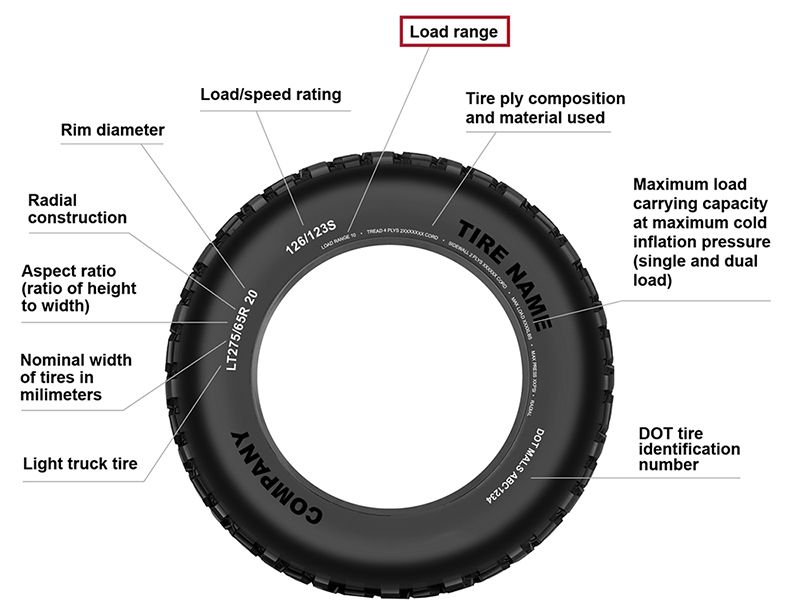
Many mistakenly believe that R- means the radius of the tire, but this is the radial design of the tire. There is also a diagonal design (indicated by the letter D), but recently it has practically not been produced, since its performance is noticeably worse.
15 - wheel (rim) diameter in inches. (It is the diameter, not the radius! This is also a common mistake). This is the “landing” diameter of the tire on the disk, i.e. is the inside size of the tire or the outside of the rim.
91 is the load index. This is the level of maximum permissible load on one wheel. For passenger cars, it is usually done with a margin and is not a decisive factor when choosing tires (in our case, IN - 91 - 670 kg.). For minibuses and small trucks, this parameter is very important and must be observed.
T is the tire speed index. The larger it is, the faster you can ride on this tire (in our case, IS - H - up to 210 km / h). Speaking about the tire speed index, I would like to note that with this parameter, the tire manufacturer guarantees the normal operation of the rubber when the car is constantly moving at the specified speed for several hours.
Speaking about the tire speed index, I would like to note that with this parameter, the tire manufacturer guarantees the normal operation of the rubber when the car is constantly moving at the specified speed for several hours.
There are two different American tire markings. The first one is very similar to the European one, only the letters “P” (Passanger - for a passenger car) or “LT” (Light Truck - light truck) are placed before the size. For example: P 195/60 R 14 or LT 235/75 R15. And another tire marking, which is fundamentally different from the European one.
Example: 31x10.5 R15 (corresponds to European size 265/75 R15)
31 is the outside diameter of the tire in inches.
10.5 is tire width in inches.
R - a tire with a radial design (older tire models were with a diagonal design).
15 is the inner diameter of the tire in inches.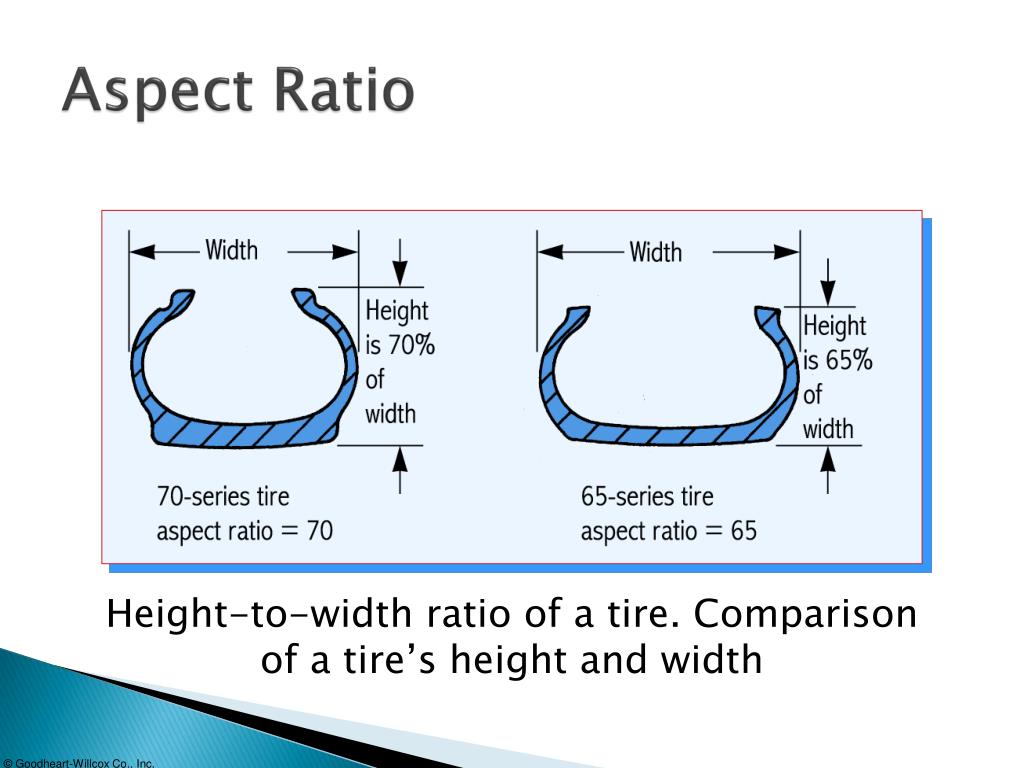
Generally speaking, except for inches that are unusual for us, the American tire marking is logical and more understandable, unlike the European one, where the height of the tire profile is not constant and depends on the width of the tire. And here everything is simple with decoding: the first digit of the standard size is the outer diameter, the second is the width, the third is the inner diameter.
XL or Extra Load is a reinforced tire, the load index of which is 3 units higher than that of conventional tires of the same size. In other words, if a given tire has a load index of 91 marked XL or Extra Load, then this means that with this index, the tire is able to withstand a maximum load of 670 kg instead of 615 kg (see the table of tire load indices).
M+S or M&S tire marking (Mud + Snow) - mud plus snow and means that the tires are all-season or winter. Many summer tires for SUVs are labeled M&S. However, these tires must not be used in winter, as winter tires have a completely different rubber compound and tread pattern, and the M&S badge indicates good flotation performance.
Many summer tires for SUVs are labeled M&S. However, these tires must not be used in winter, as winter tires have a completely different rubber compound and tread pattern, and the M&S badge indicates good flotation performance.
All Season or AS all season tires. Aw (Any Weather) - Any weather.
Pictogram * (snowflake) — rubber is designed for use in harsh winter conditions. If this marking is not on the sidewall of the tire, then this tire is intended for use only in summer conditions.
Aquatred, Aquacontact, Rain, Water, Aqua or icon (umbrella) Special rain tyres.
Outside and Inside ; asymmetric tires, i.e. It is important not to confuse which side is the outside and which is the inside. When installing, the Outside inscription must be on the outside of the car, and Inside on the inside.
RSC (RunFlat System Component) - RunFlat tires are tires that allow you to continue driving at a maximum speed of 80 km/h with a FULL tire pressure drop (puncture or cut). On these tires, depending on the manufacturer's recommendations, you can drive from 50 to 150 km. Different tire manufacturers use different designations for RSC technology. For example: Bridgestone RFT, Continental SSR, Goodyear RunOnFlat, Nokian Run Flat, Michelin ZP etc.
On these tires, depending on the manufacturer's recommendations, you can drive from 50 to 150 km. Different tire manufacturers use different designations for RSC technology. For example: Bridgestone RFT, Continental SSR, Goodyear RunOnFlat, Nokian Run Flat, Michelin ZP etc.
Rotation or arrow this marking on the tire sidewall indicates a directional tire. When installing the tire, you must strictly observe the direction of rotation of the wheel, indicated by the arrow.
Tubeless - tubeless tire. In the absence of this inscription, the tire can only be used with a camera. Tube Type - indicates that this tire must be used only with a tube.
Max Pressure ; maximum allowable tire pressure. Max Load - the maximum allowable load on each wheel of the car, in kg.
Reinforced or the letters RF in the size (for example 195/70 R15RF) means that this is a reinforced tire (6 layers). The letter C at the end of the size (for example 195/70 R15C) indicates a truck tire (8 layers).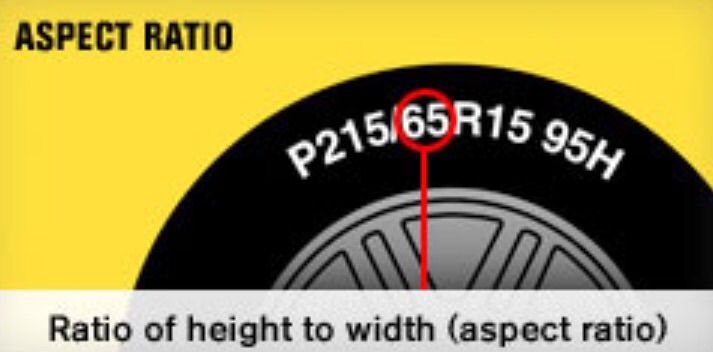
Radial this marking on the rubber in the standard size means that it is a radial construction tire. Steel means that there is a metal cord in the tire structure.
Letter E (in a circle) - the tire meets the European requirements of ECE (Economic Commission for Europe). DOT (Department of Transportation - US Department of Transportation) is an American quality standard.
Temperature A, B, or C Temperature resistance of the tire at high speeds on the test bench (A is best).
Traction A, B, or C Tire wet braking capability.
Treadwear ; relative expected mileage compared to a specific US standard test.
TWI (Tread Wear Indiration) - tire tread wear indicators. The marking on the TWI wheel can also be with an arrow. Pointers are located evenly in eight or six places around the entire circumference of the tire and show the minimum allowable tread depth.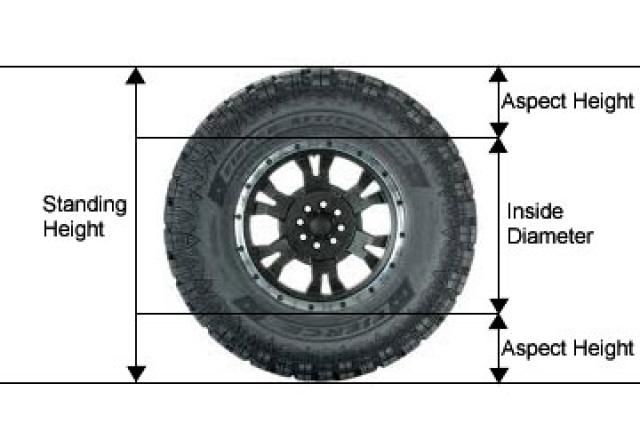 The wear indicator is made in the form of a protrusion with a height of 1.6 mm (the minimum tread value for light vehicles) and is located in the tread recess (usually in the drainage grooves).
The wear indicator is made in the form of a protrusion with a height of 1.6 mm (the minimum tread value for light vehicles) and is located in the tread recess (usually in the drainage grooves).
DOT - Manufacturer's coded address, tire size code, certificate, issue date (week/year).
Tire Finder / Tire Catalog
Use our tire size calculator to calculate the diameter, width, sidewall, circumference and RPM of any tire. Simply enter a metric or standard tire and click "Calculate".
inch measuring tires are fairly easy to understand, but metric tires use a more difficult to read system The first number on a metric tire is the width in millimeters. Divide this number by 25.4 to get the equivalent in inches, since there are 25.4 mm in 1 inch. The third number, usually preceding the "R", is the diameter of the wheel. The sidewall or aspect ratio is used in metric tire sizes to determine the overall height of the tire.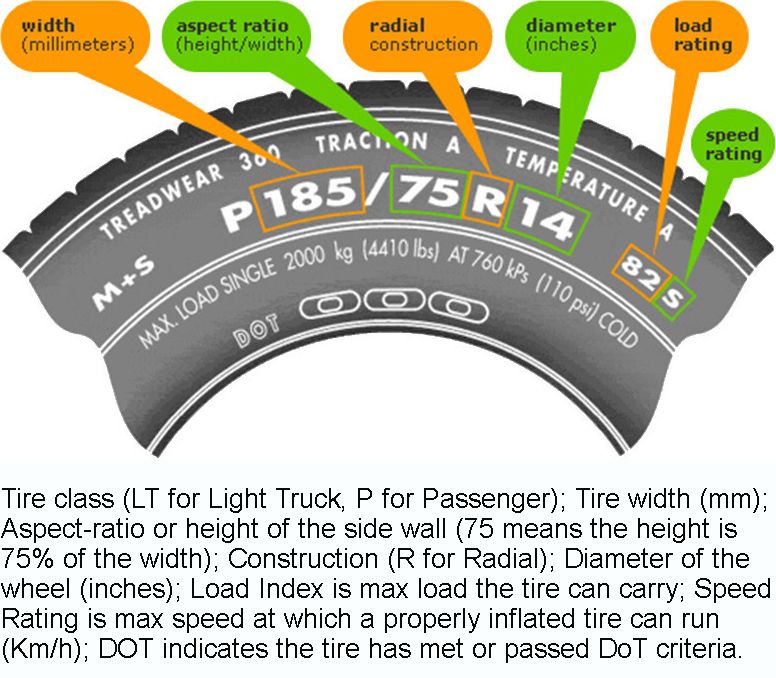 The second number on a metric tire is the sidewall measurement calculation. Sidewall height as a percentage of tire width. This second number is that percentage. The sidewall height or "aspect ratio" of a 285/75/R16 tire is 75% of 285mm.
The second number on a metric tire is the sidewall measurement calculation. Sidewall height as a percentage of tire width. This second number is that percentage. The sidewall height or "aspect ratio" of a 285/75/R16 tire is 75% of 285mm.
To calculate the diameter of a metric tire in inches: (# 1 x # 2/2540 x 2) + (# 3)
Example: 285 / 75R16 (285 X 75/2540 x 2) + 16 = 32.8 inches high.
Our tire calculator will help you with this. Just enter any tire size and click "Calculate". It also solves the problem of choosing the tire you would like to run on if you have tire sizes in inches but can't find a company that makes tires of that size. Simply enter the required inch sizes and the screen will display recommended tire sizes that are one inch over and one inch under the entered tire size. Metric tires have more options and options, so using a tire size calculator can be very helpful.
The tire size comparison calculator measures two tires and compares diameter, width, sidewall, circumference and rpm.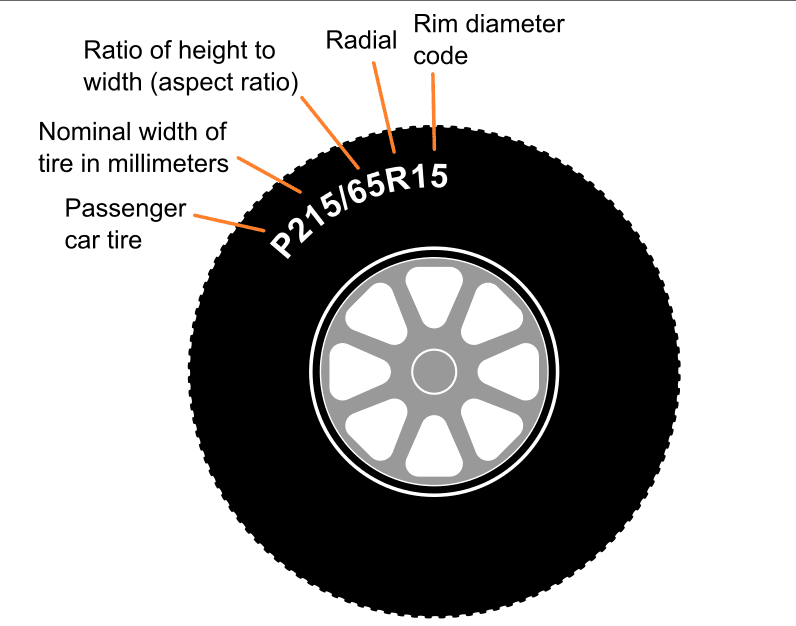 Then, as a bonus, it shows examples of speedometer readings with the first tire and the actual speed you're cruising at if you need to install a second tire. A very useful tire calculator when looking for tires of a different size than stock.
Then, as a bonus, it shows examples of speedometer readings with the first tire and the actual speed you're cruising at if you need to install a second tire. A very useful tire calculator when looking for tires of a different size than stock.
Another one of our tire size calculators is our Speedometer Correction Calculator. This is useful if you are planning on or already running larger tires than your stock tires and want to know the speed you are actually cruising compared to the speedometer reading. A larger tire has a larger circumference, thereby covering more distance for each revolution. The speedometer shows the number of revolutions of your tires, not how far you travel. Therefore, you actually go faster than your speedometer says when you have more tires than stock, and slower than your speedometer if you have smaller tires.
Our easy-to-use tire size calculators will always come in handy at one time or another. Tire Size Conversion Calculator or Tire Diameter Calculator is the best way to get the answers you are looking for when it comes to tire sizes. What sets us apart is our tire advice For each tire size you enter, our tire calculator suggests several tire sizes that are one inch larger and smaller than the tire size you entered. Select each link to see a list of tires that are made in that size. Clicking on each tire will then take you to our price comparison guide, where we list a range of companies that sell each tire. Follow the price check buttons to view prices from each distributor. Make it as easy as possible to find tires that are right for you at the best price.
What sets us apart is our tire advice For each tire size you enter, our tire calculator suggests several tire sizes that are one inch larger and smaller than the tire size you entered. Select each link to see a list of tires that are made in that size. Clicking on each tire will then take you to our price comparison guide, where we list a range of companies that sell each tire. Follow the price check buttons to view prices from each distributor. Make it as easy as possible to find tires that are right for you at the best price.
Also browse our Jeep tire category and offer pages, 4X4 tires, cheap new tires, all season tires, cheap truck tires, all season tires and free shipping tires.
,
Before buying a new tire for your car, you should know what size it is, as well as other characteristics such as tire maintenance and construction. If you don't purchase a tire designed to work with your vehicle, or one that doesn't fit other tires, you'll experience steering problems and lose efficiency and productivity.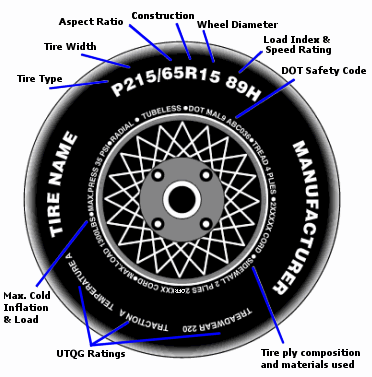 Use this guide to understand what all the numbers and letters on the tire sidewall mean.
Use this guide to understand what all the numbers and letters on the tire sidewall mean.
Service Type indicates what type of vehicle the tire is made for. For example, some tires are for passenger cars while others are for large trucks. The type of service is indicated by the previous letter on the tire size and marked on the sidewall of the tire.
Although service type is not a measurement, it helps you find the correct tire size for your vehicle. There are differences related to the type of service, such as tread depth and the number of plies used to make the tire, but these numbers are not used in determining the overall tire size.
Step 1: Find the group of numbers on the side of your tire. The number group is the tire size, given in a format such as "P215/55R16".
Step 2: Determine the previous letter on tire size . In this example, "P" is the service type indicator.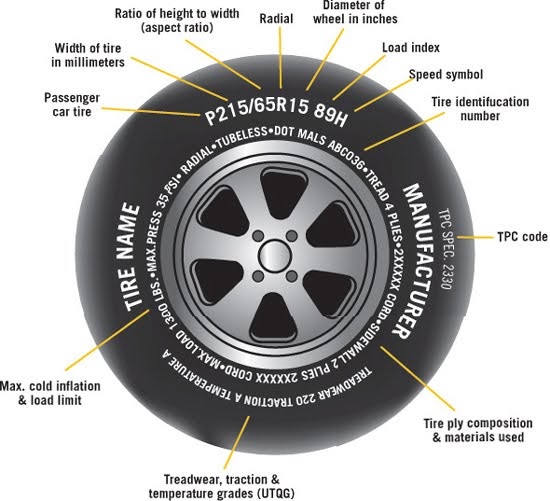
The letter indicates which vehicle category the tire is intended for. Here are the possible letters you will see for the type of tire service:
T for temporary tire or spare tire
Note : Some tires do not come with a service type letter. , this means that the tire has a "metric" size. You will most often see this type of tire for European vehicles.
The section width is the number that comes immediately after the service type as a three-digit number. Section Width indicates the overall width of the tire when fitted to the appropriately sized wheel. It is measured at the widest point of the inner sidewall relative to the widest part of the outer sidewall. Wider tires generally provide more traction for the vehicle, but can be heavier and cause more fuel consumption.
Step 1: Read the first set of numbers after the letter . It will be three digits long and will measure the width of your tire in millimeters.
For example, if the tire size is P 215 / 55R16, the tire section width is 215 millimetres.
Aspect ratio is the height of the tire's inflated sidewall relative to the profile width. Measured as a percentage. A higher number for the aspect ratio indicates a taller sidewall. A tire with a higher compression ratio, such as "70", provides a smoother ride and less road noise, while a lower compression ratio provides improved handling and cornering.
Step 1: Find the aspect ratio of . This is a two-digit number immediately after the slash, after the section width.
Step 2: Calculate the height of the side wall . If you want to get the sidewall height measurement in millimeters, multiply the section width by the ratio number and then divide by 100.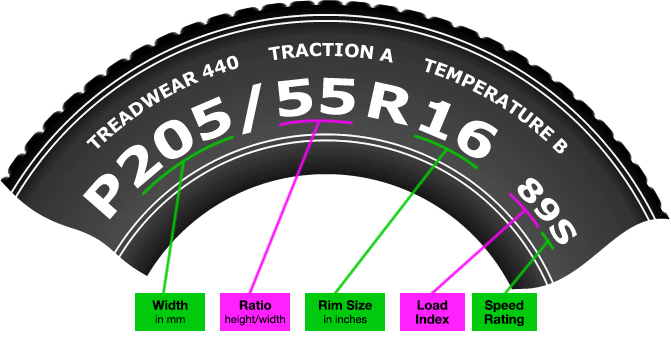
For example, let's use a tire size P215 / 55R16. Multiply 215 (section width) by 55 (aspect ratio). Answer 11 825.
Divide this number by 100 because the aspect ratio is a percentage and your sidewall height is 118.25mm.
Step 3: Find the next letter immediately after the second set of numbers . This describes how the layers on the tire are built, but does not indicate the size of the tire.
The vast majority of passenger cars these days will have an "R" for this section, which means it's a radial tire.
Another type of tire design, the displacement layer, is obsolete and typically exhibits excessive wear and higher fuel consumption.
One of the most important numbers on your tire is the diameter. The tire you choose must be suitable for your car's rim rim. If the tire bead is too small, you will not be able to fit the tire onto the rim and seal it. If the inside diameter of the tire is too large, it won't sit on the rim to seal it, and you won't be able to inflate it.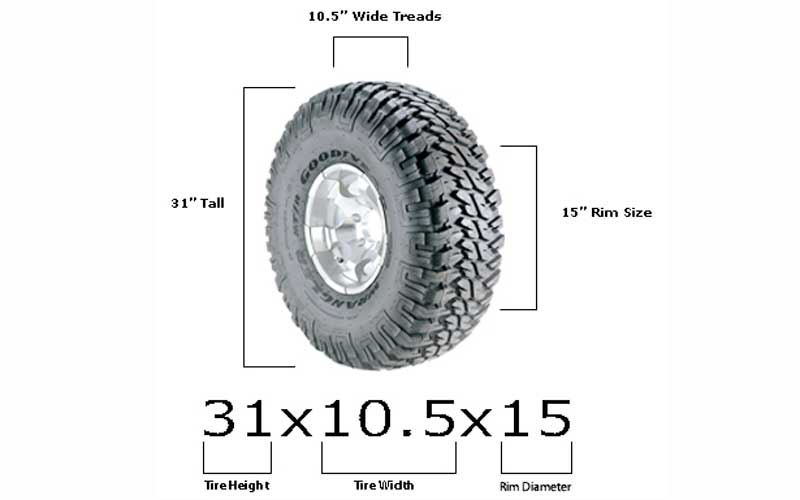
Step 1: Find the number after the aspect ratio of . To find the tire and wheel diameter, look at the last number in the size sequence.
This is usually a two-digit number, but some larger sizes may include a decimal point, such as "21.5".
This number will tell you what tire size you need to fit the wheels on your car.
Tire and wheel diameter measured in inches.
For example, the P215 / 55R 16 has a tire and wheel diameter of 16 inches.
Choosing the right tires can change your driving experience. Replacing your tire with tires with the correct performance is important if you want to ensure its fit, performance and safety.
Sometimes excessive wear on one tire can be an indicator of another problem with another vehicle system, such as a problem with the brakes or suspension system. If you would like to check your systems before changing a tire, YourMechanic certified mechanic can check your vehicle's excessive wear problem to make sure all other systems are working properly before replacing.
,
Fitting the correct tires to your vehicle is important to the overall performance and safety of your vehicle. Your choice of tires should reflect the conditions you are driving in and your preference for vehicle response and handling. You need to understand what tire size is right for your vehicle so you can make the right choice when it's time to buy tires.
Fortunately, finding the correct tire size for your vehicle is fairly easy. All the information you need is immediately available, either in your vehicle owner's manual or somewhere inside the vehicle itself. If you already know your tire size and would like to find Bridgestone tires to fit your vehicle, visit our Tire Catalog.
Although actual physical measurements such as width and diameter are factors in determining the correct tire size, additional details must be considered. Things like Load Index and Speed Rating are also integral to finding the right tires.
No matter what car you drive, finding the manufacturer's recommended tire size should be easy. The best place to start is in your owner's manual.
Don't worry if you can't find the manual; You can also find a tire fitting guide at the following locations:
Assuming they are the correct size, you can find tire size data on the sidewall of your current tires. However, no matter where you find your tire size, you will have to decipher the sequence of numbers and letters.
Let's see what each number or letter means, one by one, in the order they appear in the tire size data. We will use this tire size as an example: P225 / 70R16 91S
For most vehicles, you will see a "P" before the start of the number sequence: P 225 / 70R16 91S. "P" is short for "P-metric" and is designated by the Tire and Rim Association for "passenger car" type. This means that the tire is intended for use primarily on passenger vehicles, which may include cars, minivans, SUVs and other light pickups. If you see "LT" instead of "P" it's because you need "light truck" tires - "LT" stands for "LT-metric" which is designated by the Tire and Rim Association for "light truck" type. tire. Light truck tires are designed for use on vehicles capable of carrying heavy loads or tractors.
"P" is short for "P-metric" and is designated by the Tire and Rim Association for "passenger car" type. This means that the tire is intended for use primarily on passenger vehicles, which may include cars, minivans, SUVs and other light pickups. If you see "LT" instead of "P" it's because you need "light truck" tires - "LT" stands for "LT-metric" which is designated by the Tire and Rim Association for "light truck" type. tire. Light truck tires are designed for use on vehicles capable of carrying heavy loads or tractors.
Similarly, "T" stands for "temporary" and means your spare tire. If you see "ST" it means "special trailer".
The first number in your tire size information is the width in millimeters of the correct tires for your vehicle: P 225 / 70R16 91S.
Tire width always refers to the measurement from sidewall to sidewall. Thus, a tire with the size "P225" is designed for a passenger car and has a nominal width of 225 millimetres.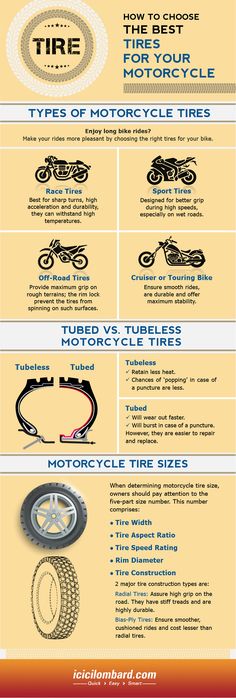
After the slash, the next number you see refers to the aspect ratio of the tire, which basically tells you how tall your tire profile is: P225 / 70 R16 91S. Aspect ratios are in percentage . Tire manufacturers calculate aspect ratio by dividing the tire's height from the rim by its width. If a tire has a compression ratio of 70, this means that the height of the tire is 70% of its width.
Lower aspect ratio tires such as the 60 series generally offer vehicle handling advantages over higher aspect ratio tires such as the 75 series.
After the aspect ratio, a letter appears indicating the type of internal structure that keeps your tire stable: P225 / 70 R 16 91S.
There are two types of construction that you can see on the sidewall of a tire:
Radial tires represent the vast majority of tires on the road in the United States today; thus, "R" is usually listed in the tire size designation.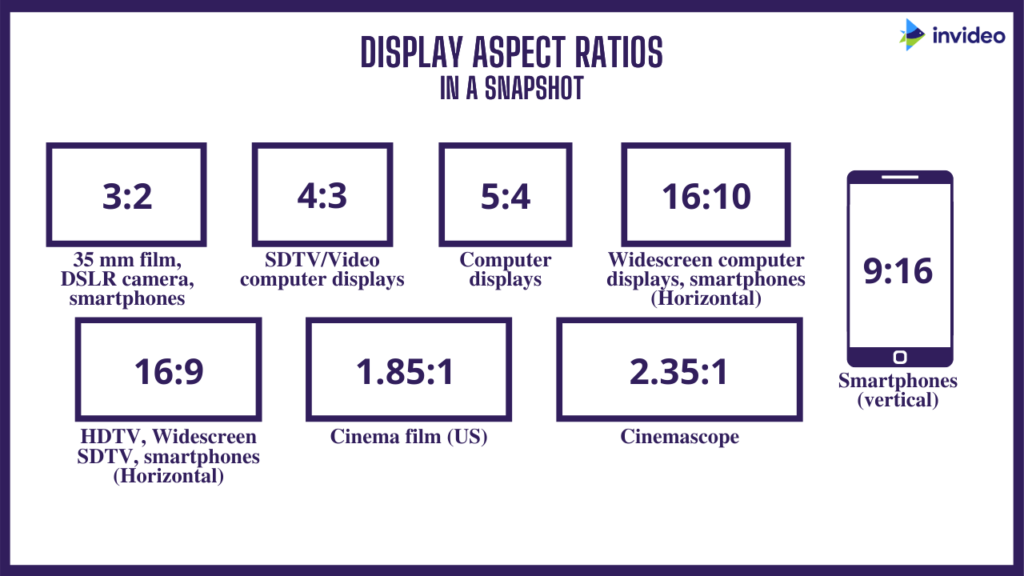 Radial design means that the inner plies of the tire are oriented in a radial direction from one bead to the other, essentially perpendicular to the axis of rotation.
Radial design means that the inner plies of the tire are oriented in a radial direction from one bead to the other, essentially perpendicular to the axis of rotation.
The next number is the code for the diameter in inches of the rim that the tire can fit on. For example, a tire with P225/70R 16 91S will fit a 16" rim.
View other overall diameter Dimensions:
The next graphic in sequence is your tire's load index, which tells us how much weight in pounds the tire can handle when fully inflated: P225 / 70R16 91 S
We call this the "load index" because the number doesn't tell us the exact number of pounds the tire can support, at least on its own. However, the number corresponds to the specific load capacity listed on the index. From 1 to 150, the numbers in the load index represent load capacities from 99 to 7385 pounds.
The last digit in the tire size sequence is the nominal speed, which is indicated by the letter: P225 / 70R16 91 S . Just like your load index corresponds to a specific load, the speed rating letter corresponds to a specific speed based on a standardized lab test.
Just like your load index corresponds to a specific load, the speed rating letter corresponds to a specific speed based on a standardized lab test.
For example, a tire with an "S" speed rating is rated up to 112 mph, while an "R" rated tire is rated up to 106 mph. Please note that this is not the recommended cruising speed. Of course, you should always follow the legal speed limits on the roads.
Higher speed tires tend to improve handling. Replacement tires must have the same or higher speed rating in order to maintain vehicle speed. If the vehicle has tires with different speed characteristics, then the maximum speed determines the speed of the "slowest" tire.
,
What was once considered the prerogative of an auto-tuning studio has become everyday life - the tire profile is gradually becoming lower, and the diameter of the disks is larger. However, one does not interfere with the other, it is enough to follow a simple rule: the outer diameter of the wheel must remain within the limits recommended by the car manufacturer. Permissible error - + 2. Then the external aesthetics will not affect the kinematics of the car's suspension and will not affect the speedometer readings. With the right tire-to-wheel ratio, tires will fit into the wheel arches without any problems and will not touch the suspension and steering parts of the car.
However, one does not interfere with the other, it is enough to follow a simple rule: the outer diameter of the wheel must remain within the limits recommended by the car manufacturer. Permissible error - + 2. Then the external aesthetics will not affect the kinematics of the car's suspension and will not affect the speedometer readings. With the right tire-to-wheel ratio, tires will fit into the wheel arches without any problems and will not touch the suspension and steering parts of the car.
In addition, there are options for alternative wheel sizes.
In the UK, the Plus Inch formula was developed. This is an increase in the diameter of the wheel in increments of one inch. Here are some example options:
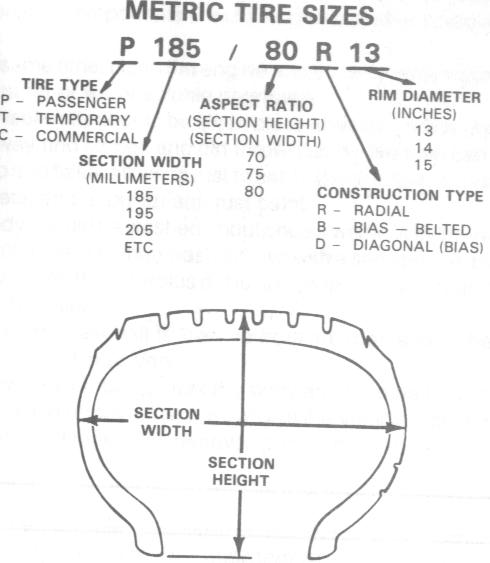
This is not the limit. The C-MAX can be fitted with even lower profile tires - 18 (225/215/40) and 19 (215/35, 245/30). True, then at speed an unexpected meeting with an impressive pothole, which is enough on our roads, can be the last for such a low-profile tire.
Now let's see how the "Plus Inch" rule works on the example of the BMW-3 series. The standard tires that are installed on this machine are 185/65 R15 and the option as an option is 205/60 R15. An alternative is wheels with tire sizes 205/55 R16 and 225/50 R16 or 215/45 R17 and 235/40 R17.
To find out how much the outer diameter of the tire has deviated from the manufacturer's recommended one, you need to make a number of calculations:
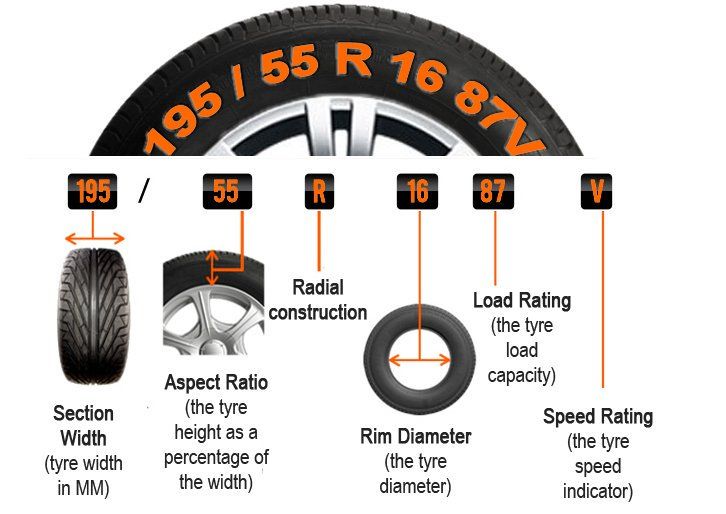
If you need data in millimeters, multiply again by 25.4.
How a tire behaves on the road depends largely on its width. A wide tire grips better on dry pavement and is less prone to wear. Narrower tires are often recommended for the winter season. It better removes water and snow from the contact patch with the road, and is more stable on loose snow. A tire of the same width can be installed on rims of different sizes, which will affect its properties during operation.
Car manufacturers often indicate in their instructions several rim sizes that are optimal for a particular car brand. The best balance of properties and performance is achieved if the rim width deviation is no more than + 1" from the recommended dimensions. The larger the rim width value, the lower the tire profile.
The larger the rim width value, the lower the tire profile.
In practice, motorists often act based on their own ideas about driving comfort, aesthetics and car handling. Guided by the wheel diameter data from the car manufacturer, they independently select the rim diameter for it. In this case, the size of the tires is selected in accordance with the height of the tire profile.
PCD - so, abbreviated from the English "Pitch Circle Diameter", denotes the diameter of the circle passing through the center of the wheel mounting hole. This term is also used by Russian manufacturers. As a rule, there are two numbers in the designation - the number of holes and their diameter. If the dimensions of the PCD are "4x100", this means that there are 4 mounting holes on a circle of 100 millimeters. This designation may look like "100/4".
Now there is no single PCD standard that would make life easier for motorists when choosing wheels. Even despite the fact that often cars of different brands are produced on the same platform. The PCD wheel size can be determined by yourself. It is easier to make a calculation for a wheel that is fastened with four bolts by measuring the distance between the inner edges of the mounting holes lying in a straight line, upper or lower, and add the diameter of one hole to this distance.
The PCD wheel size can be determined by yourself. It is easier to make a calculation for a wheel that is fastened with four bolts by measuring the distance between the inner edges of the mounting holes lying in a straight line, upper or lower, and add the diameter of one hole to this distance.
You can do the same if there are 6 mounting holes in the wheel. You can also measure the distance from the center to the center of adjacent holes, then multiply the result by two. If you use this technique, then if there are 5 mounting holes, the multiplier is 1.7012, if there are three holes, you need to multiply by 1.154.
Having a caliper available, you can find out the PCD value in another way. Having measured the diameter of the central hole and the distance from it to the far and near points of the mounting hole, we add up the readings of these three measurements. The resulting result is the PCD value for a particular wheel.
When measuring, you need to try to make them as accurate as possible, otherwise problems cannot be avoided. A difference of 1-2 millimeters from the required dimensions will affect the driving performance of the car and its operation. Example: a wheel from Fiat cars with a PCD value of 4x98 is visually indistinguishable from Opel wheels with a size of 4x100. If you install Fiat instead of Opel or vice versa, then there will be a strong beating even from a perfectly balanced wheel. And even worse: installing a wheel with a close, but not suitable PCD size on a car can lead to stripping of the threads on the flanges and bolts.
A difference of 1-2 millimeters from the required dimensions will affect the driving performance of the car and its operation. Example: a wheel from Fiat cars with a PCD value of 4x98 is visually indistinguishable from Opel wheels with a size of 4x100. If you install Fiat instead of Opel or vice versa, then there will be a strong beating even from a perfectly balanced wheel. And even worse: installing a wheel with a close, but not suitable PCD size on a car can lead to stripping of the threads on the flanges and bolts.
For this parameter, the designation ET is most often used (from the German Einpress Tieffe - pressed into the plane). Another not common designation for this parameter is the English word "offset".
If we imagine that a conditional plane passes in the middle of the wheel rim, then the distance from it to the plane of the wheel attachment is “ET” - departure. If the planes coincide, then the value of "ET" is equal to zero, the so-called zero overhang. With a positive value of "ET", the plane of symmetry of the rim protrudes beyond the plane of attachment. Conversely, a negative value of "ET" means that the plane of the wheel attachment protrudes beyond the plane of symmetry of the rim.
With a positive value of "ET", the plane of symmetry of the rim protrudes beyond the plane of attachment. Conversely, a negative value of "ET" means that the plane of the wheel attachment protrudes beyond the plane of symmetry of the rim.
Most modern passenger cars have a positive offset, while all-wheel drive vehicles have a zero or negative "ET" value. Changing this value affects the kinematics of the suspension, the service life of the bearings and the handling of the car.
A deviation of the “ET” value by 5 mm is permissible. A deviation of more than 5 mm will affect the kinematics of the suspension, the load on the bearings will increase, and the stability and controllability of the machine will deteriorate. The lower the “ET” value, the more the wheel protrudes from the arch opening. And the combination of low offset and increased rim width will cause the wheel to bulge out of the arch. This is unacceptable due to a number of technical requirements and, first of all, security parameters.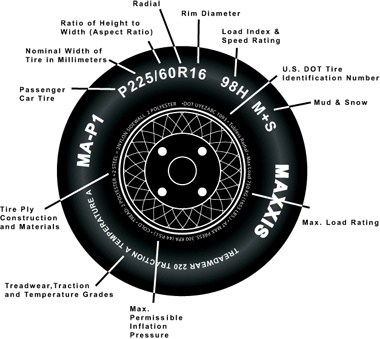
Contrary to the misconception of many, wheel nuts do not fix or center the wheel on the hub - they just press the rim against the flange. The function of centering the disk on the hub is performed by the central wheel hole. Cars of different brands have different sizes of the center hole of the wheel. This should be taken into account when installing the wheels - if it turns out that it is smaller than the corresponding diameter of the hub and / or the diameter of the annular protrusion of the axle shaft, you will have to bore the inner diameter of the wheel center hole.
In the reverse situation, if the diameter of the central hole of the wheel is larger, adapters will be needed to install the wheel - special metal rings, the outer diameter of which matches the inner diameter of the central hole of the wheel, and the inner one corresponds to the diameter of the hub. Given this problem, most car wheel manufacturers also make adapter adapters.
Problems when installing a wheel on a car can occur even if the rim width, PCD, offset and center hole diameter match. The most common cause is disc brake interference due to a protruding caliper. In rare cases, levers or a tie rod end become an obstacle. Therefore, if the wheel manufacturer did not recommend it for installation on your car, you need to do a trial "fitting" of the wheel disk. It may be necessary to re-fit after mounting the tire on the rim. If the wheels hit the car arches, body tuning will also be required.
Wheel manufacturers produce them with two types of flanges, designed for tubeless and tube tires. At first glance, everything is simple, but you should carefully look at the numbers and letters in the disc markings. Basically, these designations are typical for tubeless tires mounted on car trailers. Still, it will not be superfluous to know how to decipher their markings.
The letter “H” (“hump”) denotes one annular flanging of the disk, which prevents the tire bead from moving inside the rim.